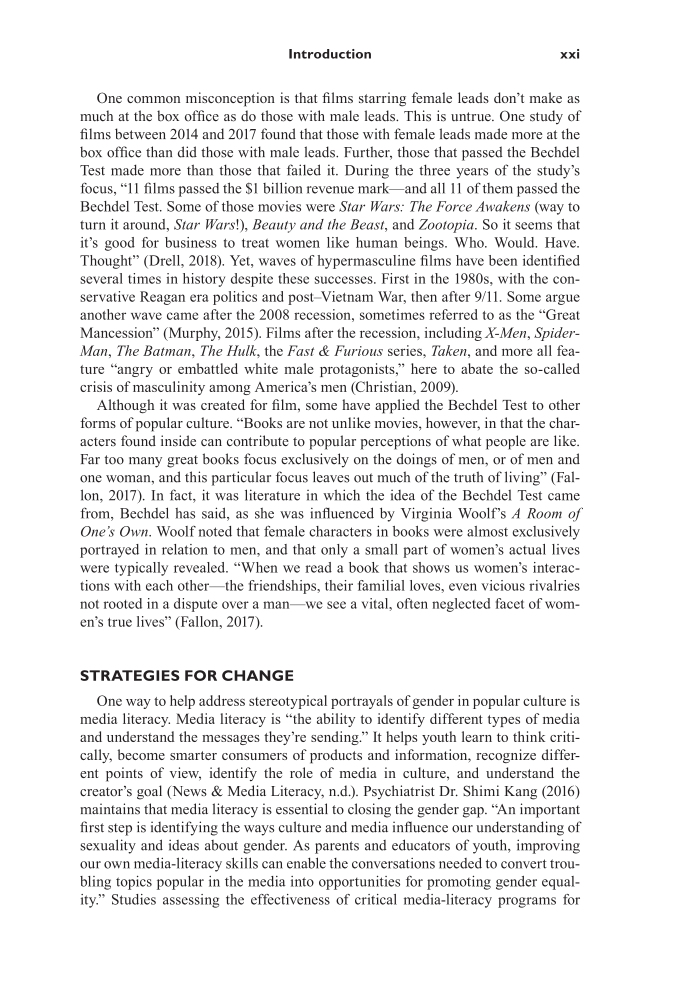Introduction xxi One common misconception is that films starring female leads don’t make as much at the box office as do those with male leads. This is untrue. One study of films between 2014 and 2017 found that those with female leads made more at the box office than did those with male leads. Further, those that passed the Bechdel Test made more than those that failed it. During the three years of the study’s focus, “11 films passed the $1 billion revenue mark—and all 11 of them passed the Bechdel Test. Some of those movies were Star Wars: The Force Awakens (way to turn it around, Star Wars!), Beauty and the Beast, and Zootopia. So it seems that it’s good for business to treat women like human beings. Who. Would. Have. Thought” (Drell, 2018). Yet, waves of hypermasculine films have been identified several times in history despite these successes. First in the 1980s, with the con- servative Reagan era politics and post–Vietnam War, then after 9/11. Some argue another wave came after the 2008 recession, sometimes referred to as the “Great Mancession” (Murphy, 2015). Films after the recession, including X-Men, Spider- Man, The Batman, The Hulk, the Fast &Furious series, Taken, and more all fea- ture “angry or embattled white male protagonists,” here to abate the so-called crisis of masculinity among America’s men (Christian, 2009). Although it was created for film, some have applied the Bechdel Test to other forms of popular culture. “Books are not unlike movies, however, in that the char- acters found inside can contribute to popular perceptions of what people are like. Far too many great books focus exclusively on the doings of men, or of men and one woman, and this particular focus leaves out much of the truth of living” (Fal- lon, 2017). In fact, it was literature in which the idea of the Bechdel Test came from, Bechdel has said, as she was influenced by Virginia Woolf’s A Room of One’s Own. Woolf noted that female characters in books were almost exclusively portrayed in relation to men, and that only a small part of women’s actual lives were typically revealed. “When we read a book that shows us women’s interac- tions with each other—the friendships, their familial loves, even vicious rivalries not rooted in a dispute over a man—we see a vital, often neglected facet of wom- en’s true lives” (Fallon, 2017). STRATEGIES FOR CHANGE One way to help address stereotypical portrayals of gender in popular culture is media literacy. Media literacy is “the ability to identify different types of media and understand the messages they’re sending.” It helps youth learn to think criti- cally, become smarter consumers of products and information, recognize differ- ent points of view, identify the role of media in culture, and understand the creator’s goal (News &Media Literacy, n.d.). Psychiatrist Dr. Shimi Kang (2016) maintains that media literacy is essential to closing the gender gap. “An important first step is identifying the ways culture and media influence our understanding of sexuality and ideas about gender. As parents and educators of youth, improving our own media-literacy skills can enable the conversations needed to convert trou- bling topics popular in the media into opportunities for promoting gender equal- ity.” Studies assessing the effectiveness of critical media-literacy programs for
Document Details My Account Print multiple pages
Print
You have printed 0 times in the last 24 hours.
Your print count will reset on at .
You may print 0 more time(s) before then.
You may print a maximum of 0 pages at a time.










































































































































































































































































































































































































































































































































































































































































































































































































